More electric vehicles in your fleet means installing more electric vehicle supply equipment (EVSE). As you plan for more of these devices, you’ll need to understand EVSE compatibility, power ratings, and cybersecurity to properly assess installation.
Federal Energy Management Program
June 28, 2022More electric vehicles in your fleet means installing more electric vehicle supply equipment, or EVSE. As you plan for more of these devices, you'll need to understand EVSE compatibility, power ratings, and cybersecurity to properly assess EVSE installation and infrastructure requirements.
More electric vehicles in your fleet means more electric vehicle supply equipment, or EVSE. As you plan for more of these devices, you'll need to understand EVSE compatibility and power ratings to properly assess their installation and infrastructure requirements.
The most common charging standards in the United States are AC Level 1 and AC Level 2, as defined by the Society of Automotive Engineers Standard, SAE J1772. Both AC-Level-1 and Level-2-EVSE provide AC power from the grid to the vehicle through the same charging port. The vehicle's on-board charger converts the energy to DC power before it reaches the vehicle's traction battery. AC-Level-2-EVSE is most commonly used in commercial applications and provides enough power for most federal fleet and workplace charging.
At most federal sites, Level 2 EVSE units deliver 208 volts at 32 amps for a power rating of 6.7 kilowatts. In contrast, the lower-power AC Level 1 charger delivers 120 volts at a maximum of 16 amps for a power rating of 1.9 kilowatts.
For a typical EV sedan, a 6.7 kilowatt Level 2 EVSE provides about 25 miles of range per hour of charge. Alternately, the lower power from AC Level 1 charges the vehicle at a rate of a little over 5 miles of range per hour.
The SAE standard also offers DC charging solutions that require a more robust charging port referred to as CCS, or the combined charging standard. The CCS includes two additional pins, enabling DC power to flow directly to the vehicle's traction battery, bypassing the power limitations of the on-board charger. The CCS includes DC Level 1 and DC Level 2 options, although power delivered to the vehicle may vary based on the vehicle's battery capabilities. DC Level 1 provides a high-powered charge rate commonly installed along major highways and is referred to as a DC fast charger, or DCFC. Common DCFCs take a 480-volt, three-phase input, and deliver 50 kilowatts to the vehicle—providing 100 to 200 miles of range in 30 minutes. While not yet commonly used, more-powerful Level-2-DC-charging, known as extreme fast charging, is anticipated to deliver 250 to 350 kilowatts of charging power. That's 100 to 200 miles of range in the time it takes to stop at a gas station.
Other charging standards include CHAdeMO, a DC charging standard used mostly by Japanese manufacturers such as Mitsubishi and Nissan, and Tesla's proprietary Supercharger standard. However, for AC charging, nearly all EV models available in the United States can use AC Level 1 and Level 2 standards.
Power levels are defined by their relationship to the voltage level and current flow. The power of a device, in watts, is equal to the voltage level, in volts, times the current, in amps.
For example, a typical Level-2-AC charger operates at 208 volts and provides the vehicle with a maximum 32 amps of current. This results in a power rating of 6.7 kilowatts delivered to the vehicle.
EVSE units are typically powered by electricity from the local utility. Power flows from generation facilities through transmission lines, substations, and distribution circuits before reaching the facilities where it powers devices and charges vehicles. Most electricity is delivered to federal buildings at a commercial level of 120 or 208 volts, depending on the type of connection. Distribution-level voltages of approximately 10,000 to 20,000 volts are lowered by a transformer to a voltage level designed for residential and commercial use.
Most distribution equipment, such as transmission lines and substations, are owned by the utility, while the facility wiring and service panels belong to the building owner. Certain large commercial buildings install and maintain their own distribution transformer, although this is not common for smaller facilities.
Understanding this breakdown is important when planning EVSE installations or equipment upgrades.
The National Electrical Code Section 625 requires that each EVSE be installed on its own dedicated circuit. This means that every unit should have a set of wires running from the EVSE to the service panel and the protection of a dedicated breaker, much like a home has a dedicated breaker for the central air conditioner.
Deciding which breaker to install is also an important consideration. SAE standard AC charging levels deliver different voltages and therefore require different types of circuit breakers. Level 1 units with a 120-volt connection require installation of a single-pole breaker on one spare breaker position in the service panel. Alternately, Level 2 units with a 208- or 240-volt connection require a double-pole breaker installed on two vertically adjacent spare breaker positions.
In addition to breaker type, the National Electrical Code requires the circuit breaker to be at least 125 percent of the EVSE maximum load current. This means that a 16-amp Level 1 unit requires a single-pole breaker rated at 20 amps in order to supply the vehicle with 1.9 kilowatts at 120 volts. A 32-amp level 2 unit requires a double-pole breaker rated at 40 amps in order to supply the vehicle with 7.7 kilowatts at 240 volts or 6.7 kilowatts at 208 volts.
As EVSE units develop more advanced features and connected functionalities, cybersecurity threats become a growing concern. Although cybersecurity attacks don't typically involve vehicle charging, fleets should consider a few possible threat vectors when purchasing EVSE.
The most obvious threat to EVSE is physical access to the control board through external ports like USB. However, wireless communication for managed charging systems or firmware updates also create the possibility for remote risks. These threat vectors could allow a malicious actor to access a user's personally identifiable information or gain operational control of the EVSE. These threats can be mitigated by requiring EVSE to have concealed physical access ports, encrypted communication and data storage, and full compliance with FedRAMP for cloud servers.
Learn more about EVSE types, installation requirements, and fleet cybersecurity, as well as additional cybersecurity mitigation techniques, on the U.S. Department of Energy's Federal Energy Management Program fleet website.
Learn more about FEMP Electric Vehicle Training.
More Videos
-
 This Take Five training covers the why and how of life cycle costing, comparison of life cycle cost savings for different energy-using products, and ensuring that products are cost effective.
This Take Five training covers the why and how of life cycle costing, comparison of life cycle cost savings for different energy-using products, and ensuring that products are cost effective. -
 This Take Five training provides an overview of energy efficiency guidelines for food storage and equipment for federal employees and food-service contractors.
This Take Five training provides an overview of energy efficiency guidelines for food storage and equipment for federal employees and food-service contractors. -
 REopt helps federal building owners and energy managers identify and understand the optimal energy solution for their facility or campus.
REopt helps federal building owners and energy managers identify and understand the optimal energy solution for their facility or campus. -
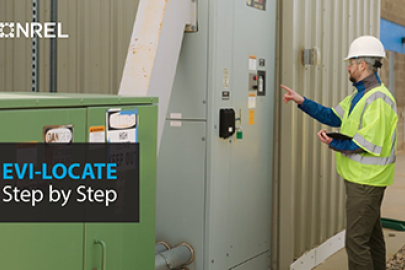 Learn how to use the Electric Vehicle Infrastructure – Locally Optimized Charging Assessment Tool and Estimator (EVI-LOCATE) web tool to guide you through the electric vehicle (EV) charging station planning process.
Learn how to use the Electric Vehicle Infrastructure – Locally Optimized Charging Assessment Tool and Estimator (EVI-LOCATE) web tool to guide you through the electric vehicle (EV) charging station planning process. -
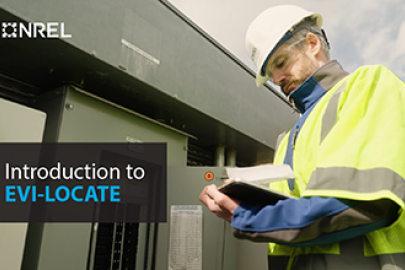 The Electric Vehicle Infrastructure – Locally Optimized Charging Assessment Tool and Estimator (EVI-LOCATE) website guides you through an interactive site assessment process and generates cost estimates and site layouts for EV charging projects.
The Electric Vehicle Infrastructure – Locally Optimized Charging Assessment Tool and Estimator (EVI-LOCATE) website guides you through an interactive site assessment process and generates cost estimates and site layouts for EV charging projects. -
 This webinar recording walks through the best practices for submitting an AFFECT application.
This webinar recording walks through the best practices for submitting an AFFECT application. -
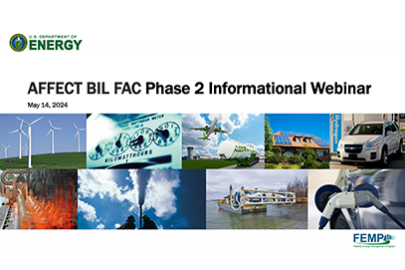 Webinar provides overview about Phase 2 of the Assisting Federal Facilities with Energy Conservation Technologies (AFFECT) Bipartisan Infrastructure Law (BIL) Federal Agency Call (FAC).
Webinar provides overview about Phase 2 of the Assisting Federal Facilities with Energy Conservation Technologies (AFFECT) Bipartisan Infrastructure Law (BIL) Federal Agency Call (FAC). -
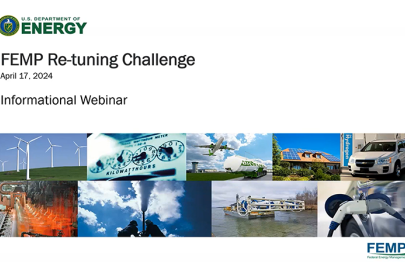 This informational webinar, hosted by the Federal Energy Management Program (FEMP), marks the launch of the 2024 FEMP Re-tuning Challenge.
This informational webinar, hosted by the Federal Energy Management Program (FEMP), marks the launch of the 2024 FEMP Re-tuning Challenge. -
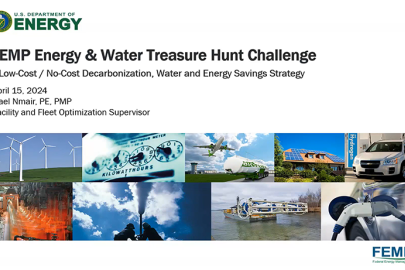 This webinar describes the foundational principles of the Federal Energy Management Program's (FEMP) Regional Energy and Water Treasure Hunt Program and helps agencies recognize no-cost, low-cost energy and water savings opportunities.
This webinar describes the foundational principles of the Federal Energy Management Program's (FEMP) Regional Energy and Water Treasure Hunt Program and helps agencies recognize no-cost, low-cost energy and water savings opportunities. -
 This training session provides an overview of how to complete the ePB template for different funding types, shows where to enter the AFFECT grant value, and describes how the information in key tabs will be used during the evaluation process.
This training session provides an overview of how to complete the ePB template for different funding types, shows where to enter the AFFECT grant value, and describes how the information in key tabs will be used during the evaluation process.

